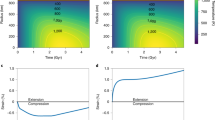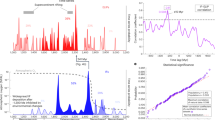Abstract
IT is important to note that if, during an expansion of the Earth, each point on the surface were to move radially outward, then all sampling areas would have the same relative geographical co-ordinates before and after expansion. Palæomagnetic results could not be used to detect an expansion of this type. However, an alternative model of expansion is that in which most or all of the increase in area is reflected by an increase in the area of the ocean basins. We considered Prof. Carey's model of Earth expansion to be of this general type, since he concludes1 that the Atlantic, Indian and Pacific Ocean basins formed by dilatation attendant on expansion. If the ocean basins formed in this way, the method we used would show an increase in the Earth's radius, even if the continents had also grown a lesser amount.
This is a preview of subscription content, access via your institution
Access options
Subscribe to this journal
Receive 51 print issues and online access
$199.00 per year
only $3.90 per issue
Buy this article
- Purchase on Springer Link
- Instant access to full article PDF
Prices may be subject to local taxes which are calculated during checkout
Similar content being viewed by others
References
Carey, S. W., C.R. III Cong. Assoc. Sci. des Pays de l'Océan Indien, Sect. C, 171 (1957).
Carey, S. W., Continental Drift: a Symposium, Fig. 10 (Univ. Tasmania, 1958).
Author information
Authors and Affiliations
Rights and permissions
About this article
Cite this article
COX, A., DOELL, R. Palæomagnetic Evidence relevant to a Change in the Earth's Radius. Nature 190, 36–37 (1961). https://doi.org/10.1038/190036b0
Issue Date:
DOI: https://doi.org/10.1038/190036b0
Comments
By submitting a comment you agree to abide by our Terms and Community Guidelines. If you find something abusive or that does not comply with our terms or guidelines please flag it as inappropriate.



